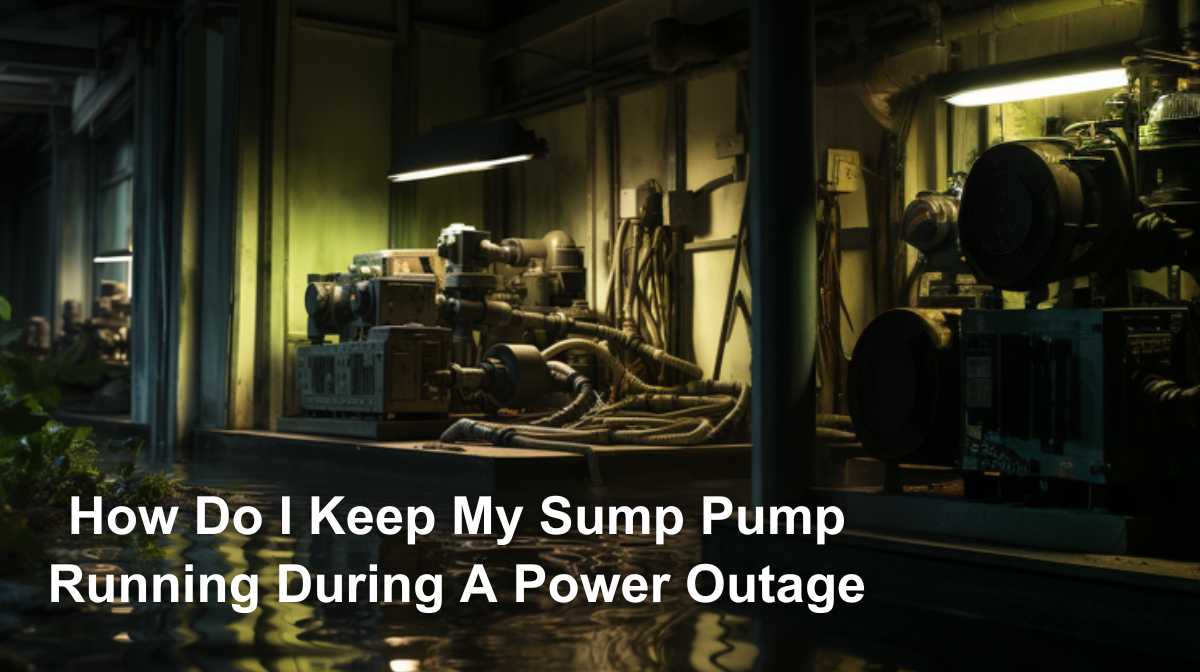Last Updated on August 22, 2023 by kiezelamquiz

A power outage can be a significant concern for homeowners who rely on sump pumps to keep their basements dry. During heavy rains or storms, sump pumps play a crucial role in preventing water from seeping into basements. But when the power goes out, you might find yourself thinking: How do I keep my sump pump running during a power outage?
To keep your sump pump running during a power outage, use a sump pump battery backup or a generator. The battery backup will provide temporary power when electricity is unavailable, while a generator is the best long-term solution.
In this article, we will guide you through the best backup systems available for sump pumps and provide essential tips for keeping it in good working order.
How To Keep Your Sump Pump Running During A Power Outage
If you want to keep your sump pump running during a power outage, a few options are available.
Battery Backup Systems
During a power outage, a battery backup system keeps your sump pump chugging along, safeguarding your basement from flooding. It is a reliable solution that ensures the continuous operation of your sump pump even when the electricity goes out.
Battery backup systems consist of a battery and an inverter that converts DC power into AC power, which can be used to run the sump pump. These systems are usually installed parallel to your main electrical supply, so they automatically take over during an outage. They provide peace of mind knowing that no matter what happens, your sump pump will continue protecting your home from water damage.
When choosing a battery backup system, consider the battery’s capacity and runtime to ensure it can handle prolonged outages effectively.
Water-Powered Backup Systems
Water-powered backup systems are a fantastic alternative to traditional battery backups because they use the force of water to keep your basement protected from flooding. They work even when the electricity is out. These systems utilize the pressure from your home’s water supply to power the sump pump during a power outage.
When electricity is lost, a valve opens and allows water to flow into the system, which powers the pump and removes any excess water from your basement.
One significant advantage of water-powered backup systems is their reliability. Unlike battery backups, which can run out of power or fail over time, these systems rely on an unlimited water source, making them highly dependable. Additionally, they do not require regular maintenance or replacement like batteries do.
It’s important to note that these systems will increase your water bill slightly due to the extra usage during a power outage. However, this small cost is well worth it for the peace of mind of knowing that your basement will remain dry and protected even during a prolonged power outage.
Generator Backup
A generator is a reliable solution to ensure your sump pump remains operational during an electrical failure.
When the power goes out, run your sump pump on a generator to keep it running smoothly and prevent basement flooding. It serves as a backup power source, allowing you to avoid potential damage and costly repairs caused by water accumulation.
So, What is The Best Backup System To Keep Your Sump Pump Running?
A generator is the best backup system to keep your sump pump running during a power outage.

A generator will provide the necessary power to keep your sump pump functioning, preventing any potential flooding in your basement or crawl space.
It’s essential to have an appropriately sized generator that can handle your sump pump and any other essential appliances you may need during an outage.
Generators come in various sizes and types, so choosing one that matches your sump pump’s power requirements is essential. A portable generator is an excellent option as it can easily be transported and connected to your sump pump system.
Select a generator with sufficient wattage and runtime capabilities to ensure continuous operation during an extended power outage. Additionally, it’s crucial to properly maintain and store your generator, following manufacturer guidelines for optimal performance.
By investing in a reliable generator, you can have peace of mind knowing that your sump pump will continue functioning even when the power goes out.
You might be interested to check out the Jackery 1500 and learn if it can power your sump pump.
Proper Installation and Connection
If you want to ensure your sump pump keeps running during a power outage, it’s crucial to properly install and connect it so that you don’t end up high and dry when the storm hits.
Here are some important tips to keep in mind.
Firstly, make sure you use the right wiring techniques. It’s essential to have a dedicated circuit for your sump pump, separate from other household appliances. This will prevent any electrical overload and ensure smooth operation during power outages.
Secondly, consider installing a backup power source such as a battery backup or generator connection. These options can provide continuous power supply to your sump pump even when the main electricity is down. A battery backup is particularly useful as it kicks in automatically during outages, while a generator connection requires manual activation.
Lastly, protect your sump pump from power surges by using surge protection devices or installing them at the main electrical panel of your home. Power surges can damage the pump motor and render it useless during critical times.
Maintenance and Precautions
Regular maintenance and precautions are essential for ensuring the reliability and longevity of both the generator and the sump pump. By proactively taking care of these devices, you can be confident that they will function optimally during critical situations. Here are the key aspects to focus on:
Generator Maintenance
Regular Inspections: Conduct periodic visual inspections of the generator to check for any signs of wear, damage, or leaks. Look for loose connections, frayed wires, or any other issues that may affect its performance.
Fuel and Oil Levels: Monitor the fuel level in the generator’s tank and refill it as needed. Additionally, follow the manufacturer’s guidelines for oil changes to keep the engine running smoothly.
Battery Check: If your generator has a battery, check its condition and charge regularly. A fully functional battery ensures smooth starting and operation during emergencies.
Test Runs: Schedule regular test runs of the generator to ensure it starts and operates correctly. This practice will help identify any potential problems and allow you to address them before an actual power outage occurs.
Storage and Shelter: If the generator is not in use for an extended period, store it in a dry and sheltered location to protect it from the elements.
Sump Pump Maintenance
Clean Intake Screens: Regularly inspect and clean the intake screens or grates to prevent debris from clogging the pump, which could impede its operation during flooding.
Check Switches and Floats: Ensure that the sump pump’s switches and floats are functioning correctly. Faulty switches can lead to improper pump activation or failure to turn on during an outage.
Inspect Discharge Lines: Check the discharge lines for any blockages or freezing, especially in colder climates. A clear and unobstructed discharge line allows water to flow freely away from the foundation.
Backup Power Testing: Periodically test the sump pump’s backup power system (e.g., battery backup) to confirm it is ready to kick in during a power outage.
Consider a Secondary Pump: Installing a secondary sump pump as a backup can provide an additional layer of protection during heavy flooding or if the primary pump fails.
Precautions
If the generator is kept outdoors, ensure it is protected from rain, snow, or other harsh weather conditions. Use weatherproof covers or enclosures to shield it.
Never operate the generator indoors or in enclosed spaces. Generators produce carbon monoxide, a deadly gas that can be lethal in confined areas. Place the generator in a well-ventilated area away from open windows, doors, and vents.
Store fuel for the generator in approved containers and in a safe location. Make sure they’re away from any potential ignition sources.
Always follow the manufacturer’s instructions and guidelines for both the generator and sump pump maintenance to ensure safe and efficient operation.
Testing the Backup System
Make sure to evaluate the functionality of your backup system regularly to ensure uninterrupted operation in case of unforeseen electricity disruption. Testing your backup system is crucial for maintaining the effectiveness of your sump pump during a power outage.
One important aspect to consider is the availability of backup power sources. It’s recommended to have a battery-powered backup system as it can provide sufficient power when needed.
Checking the sump pump battery life is also essential. Batteries should be inspected and replaced if necessary, ensuring they’re fully charged and capable of sustaining a sump pump for an extended period.
Additionally, consider installing a power outage alert system that notifies you immediately when there’s a disruption in electricity supply.
Regular testing allows you to identify any potential issues before an actual power outage occurs. By conducting periodic tests, you can troubleshoot backup system failures promptly and make any necessary repairs or replacements. This proactive approach will help keep your sump pump running smoothly during critical moments.
Remember, regular maintenance and testing are vital for ensuring that your backup system operates efficiently during a power outage. So don’t neglect this important task and take the necessary steps to protect your home from potential water damage caused by a malfunctioning sump pump during an electrical disruption.
Safeguard Your Home: Ensure Your Sump Pump’s Uninterrupted Operation
So there you have it, a comprehensive guide on keeping your sump pump running during a power outage. Remember, investing in a reliable backup system is crucial in ensuring the continuous operation of your sump pump when the lights go out.
Did you know that according to the Insurance Institute for Business & Home Safety, basement flooding can cause an average of $4,000 worth of damage? Don’t let yourself become part of that statistic – take proper measures to maintain your sump pump and protect your home from potential water damage.

Scott Krager purchased generatorgrid.com in the summer of 2020 and quickly began to buy every generator under the sun! He currently has over a dozen generators and the number is growing quickly. He lives in Portland, OR near his family and friends.
GeneratorGrid.com is an independent review business. I am not affiliated with any manufacturers and do not accept paid reviews. When you buy through my links, I may earn a commission which helps me purchase more generators for testing. - Scott Krager

